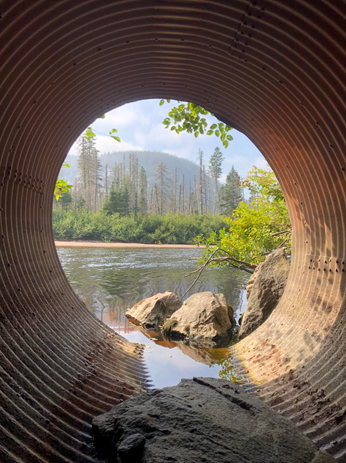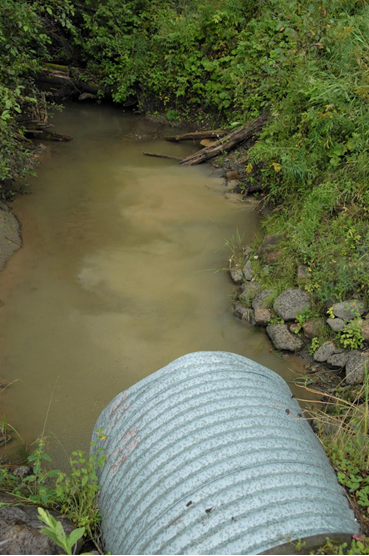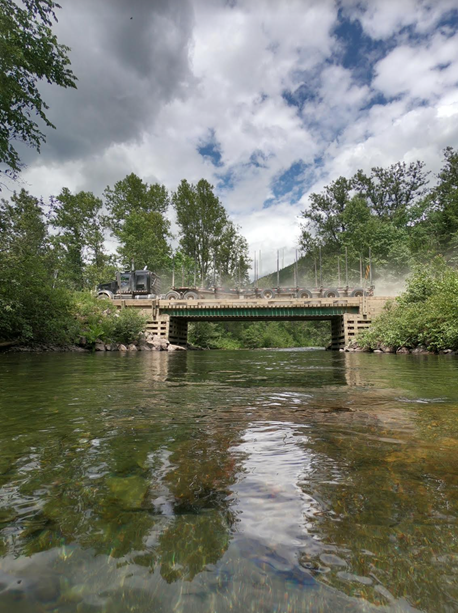Scientific projects
LAND USE PLANNING
Research on the impact of forestry and water management on salmon
LAND USE PLANNING AND SALMON RIVERS
Salmon habitat is directly related to the quality of the environment within watersheds. The land use and use of the land along rivers and tributaries has a direct effect on the streams. Upstream impacts can affect the entire river system and threaten the survival of salmon at various life stages. It is therefore very important to respect and promote the integrity of their habitat in land use planning processes. The FQSA is interested in all activities carried out on forest land, but pays particular attention to the omnipresence of silvicultural work carried out in the watersheds of salmon rivers. The impacts of forestry and hydraulic engineering on Quebec's natural ecosystem are multiple and complex, particularly in terms of biodiversity, natural habitats and wildlife populations.
The biology of Atlantic salmon is a complex science. Forestry and hydraulic activities in the watersheds where these fish live can have an impact on their optimal survival conditions. These impacts can manifest themselves in various forms. In order to preserve salmon populations in rivers, it is essential to have a thorough knowledge of the territory and that it be effectively integrated into land use planning. In this regard, with funding from the Fondation de la faune du Québec, the FQSA provides professional and technical support to river managers in the regions to ensure that the wildlife interests of Atlantic salmon are taken into account. The FQSA also participates in numerous committees and issue tables for forest management and other activities related to land use planning in salmon river watersheds.
Current Projects
Minimizing the impact of culverts on Atlantic salmon habitat
This project aims to develop a geomatics method based on a multi-criteria spatial analysis to identify and characterize stream crossings that may pose a risk to Atlantic salmon habitat. This analysis allows us to specifically target culverts that may cause erosion issues and those that may cause habitat fragmentation. We then conducted a field inventory of a proportion of these culverts, geo-referencing them and performing a detailed characterization of the culvert and nearby aquatic habitat, using a questionnaire on the ArcGIS 123 Survey application.
This project is funded by the Fondation de la faune du Québec (FFQ) and the Atlantic Salmon Conservation Foundation (FCSA).

PROJECT IN PROGRESS
Development of a methodology to evaluate the hydromorphological sensitivity related to logging in the watersheds of salmon rivers in the Gaspé and Bas-St-Laurent regions.
The Geomorphology and Fluvial Dynamics research laboratory of UQAR is working on the development of a method to evaluate the hydromorphological sensitivity of salmon river watersheds to logging. The ultimate goal is to evaluate and better understand how rivers and salmon habitats evolve in response to changes in forest cover in watersheds.
This project is carried out in partnership with the FQSA, the Conseil de l'eau du Nord de la Gaspésie and with funding from the Atlantic Salmon Conservation Foundation.

The following are the main concerns related to salmon habitat protection and sport fishing activities in relation to forest management:
Key issues related to salmon habitat:
- The level of harvesting in the watershed
- Condition of forest roads and stream crossings
- Wooded edges and riparian buffers
Key issues related to the fishing experience:
- Alteration of the landscape
- Tranquility of the area
- Accessibility to the territory and safety for users
Documentation
- Revue de littérature : les impacts environnementaux liés à la présence des barrages sur l'habitat aquatique du saumon atlantique (2024)
- Trame verte et bleue : joindre la nature et les milieux urbains (2023) (no 126)
- Agriculture et rivières à saumon : harmonisation et usages du territoire (2021) (no 119)
- Constats Colloque Saumon et Foresterie (2017)
- Développement des stratégies et de modalités de protection de l'habitat du saumon dans un contexte de gestion intégrée forêt-faune (2012)
- L’occupation du territoire et les sociétés d’aménagements (2008)
- Mémoire sur l’aménagement durable des forêts (2011)

